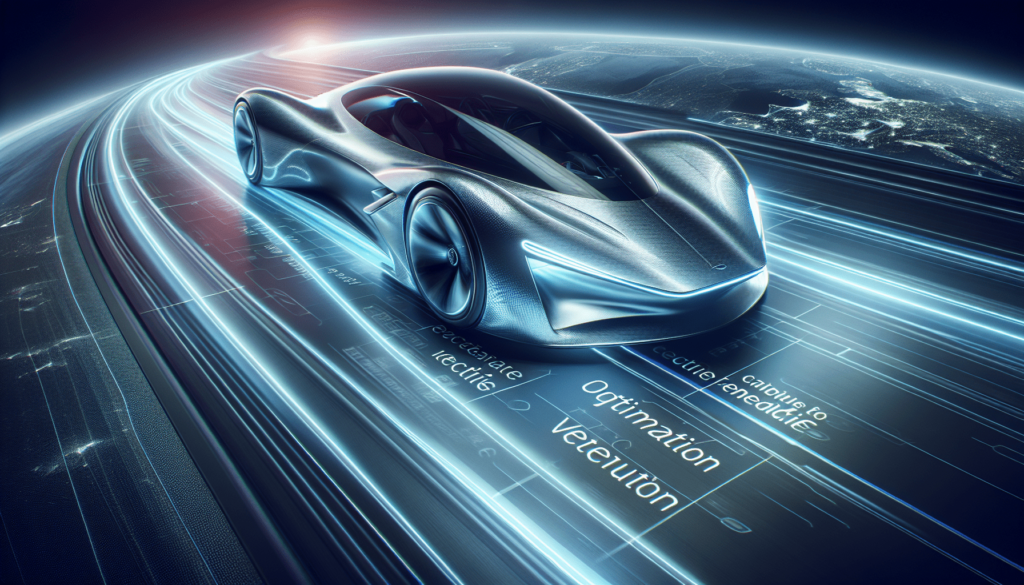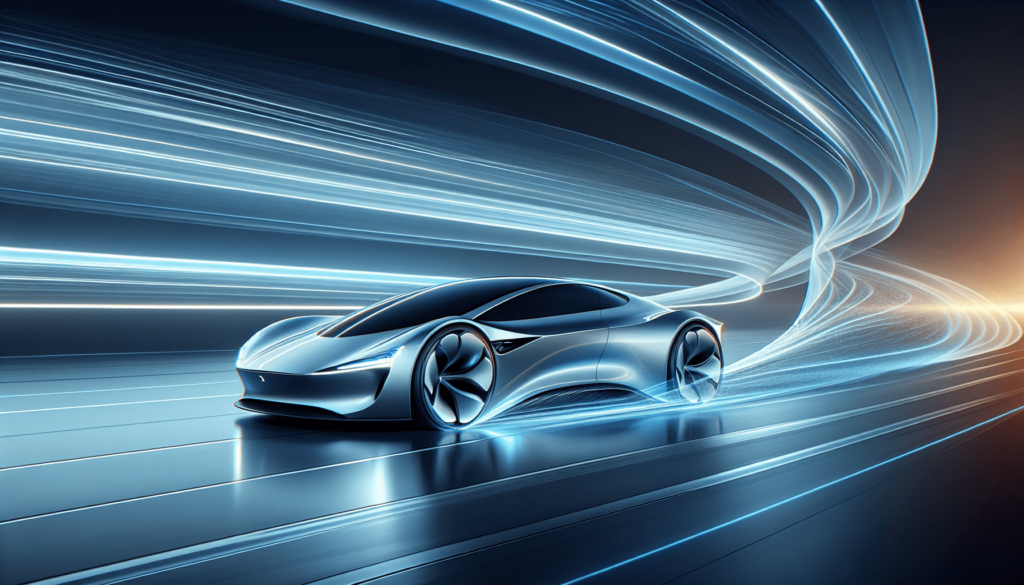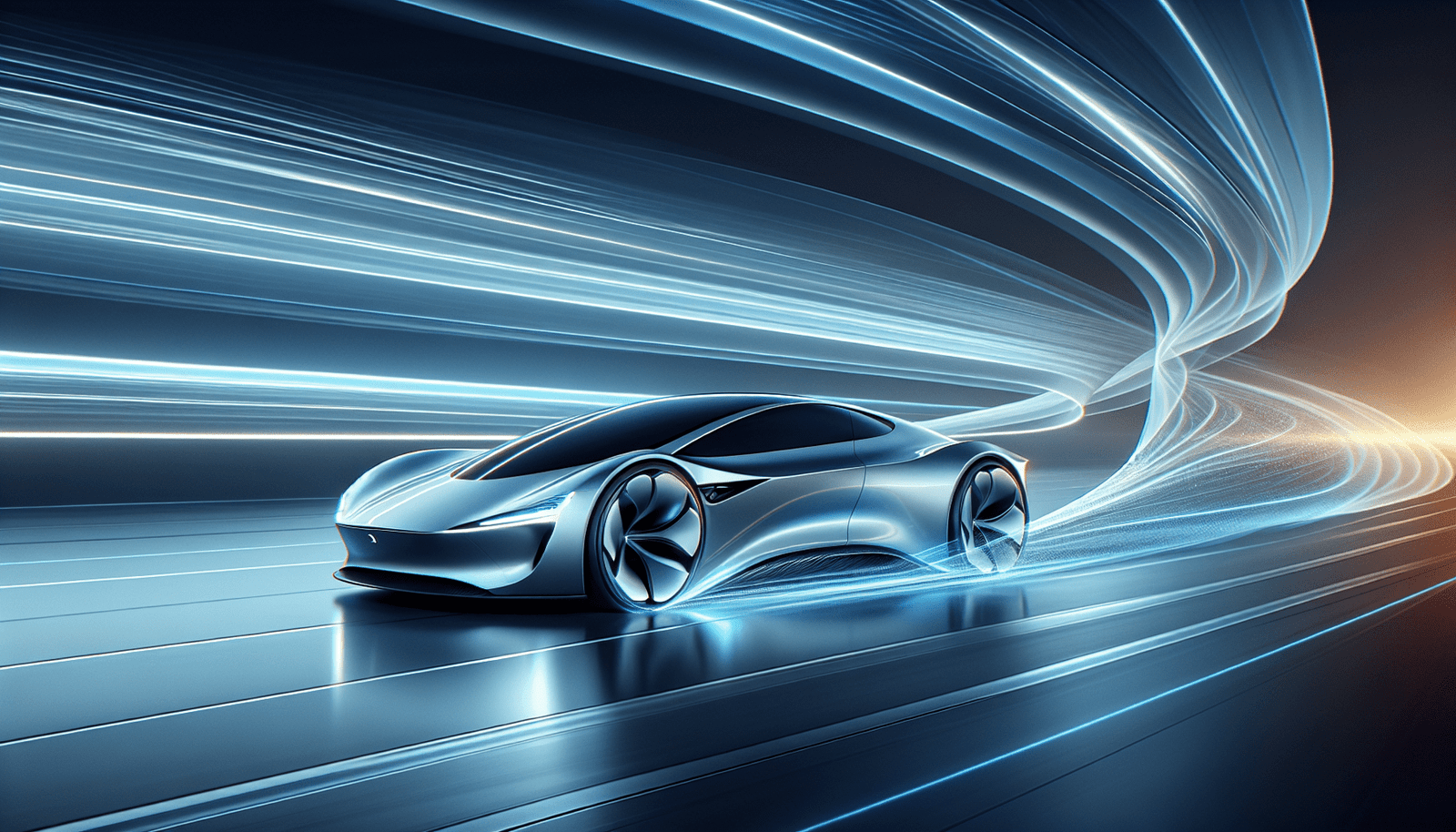Electric cars are rapidly gaining popularity as more and more people switch to greener alternatives. Yet, one of the key challenges in developing efficient electric cars lies in optimizing their aerodynamics. This article delves into the fascinating world of aerodynamics and explores how engineers are utilizing innovative designs to enhance the efficiency of electric cars. By understanding the crucial role that aerodynamics plays, we can gain insight into the impressive advancements being made in this field, pushing electric cars closer to a sustainable future. So, let’s take a closer look at the ways in which aerodynamics is being optimized for electric car efficiency!
Streamlining the Body Design
When it comes to optimizing aerodynamics for electric car efficiency, one of the key aspects to focus on is streamlining the body design. By reducing the drag coefficient, designers can significantly improve the car’s overall efficiency and range.
Reducing Drag Coefficient
The drag coefficient is a measure of how much resistance the car encounters as it moves through the air. A lower drag coefficient means that the car can move more easily, requiring less energy. Electric car manufacturers are investing heavily in designing cars with a reduced drag coefficient to maximize efficiency.
Through careful design and engineering, manufacturers are employing techniques such as tapering the front and rear ends, smoothing out the body contours, and minimizing sharp edges to reduce drag. By streamlining the body shape, electric cars can overcome air resistance more efficiently, leading to improved energy efficiency and extended range.
Designing Sleek and Curved Body Panels
Another aspect of streamlining the body design is the incorporation of sleek and curved body panels. These curved panels are designed to reduce air resistance and create a smoother airflow around the car. By minimizing disruptions in the airflow, the car can glide through the air more effortlessly, resulting in improved efficiency.
Manufacturers are utilizing advanced design techniques to create smooth contours and curved surfaces that minimize turbulence and enhance aerodynamic performance. This seamless integration of sleek body panels not only improves the car’s efficiency but also adds to its visual appeal.
Incorporating Active Aerodynamic Features
To further optimize aerodynamics, electric cars are increasingly being equipped with active aerodynamic features. These features include adjustable spoilers, movable components, and adaptive air vents that can be controlled to optimize the car’s aerodynamic profile based on driving conditions.
By dynamically adjusting these active features, the car can respond to different situations, such as high-speed driving or heavy crosswinds, to reduce drag and improve stability. These active aerodynamic features are an important tool in achieving optimal electric car efficiency.
Optimizing the Underbody
In addition to streamlining the body design, optimizing the underbody of an electric car is crucial for achieving maximum aerodynamic efficiency. The underbody plays a significant role in managing airflow and reducing drag.
Enhancing Airflow with Smooth Underbody Panels
One approach to optimizing the underbody is the use of smooth panels that guide the airflow more efficiently. By minimizing turbulence and redirecting airflow away from mechanical components, these panels help reduce drag and improve overall efficiency.
Manufacturers are employing advanced manufacturing techniques to create seamless underbody panels that follow the contour of the car. These panels not only enhance aerodynamics but also contribute to reducing noise and increasing the overall comfort of the vehicle.
Adding Air Curtains and Wheel Deflectors
To further enhance underbody airflow, electric cars are often equipped with air curtains and wheel deflectors. Air curtains are small air channels located near the front wheels that guide air along the sides of the car, reducing turbulence and drag. Wheel deflectors, on the other hand, are designed to direct airflow away from the wheels, reducing drag caused by rotating wheels.
These features work in conjunction with other aerodynamic components to optimize the airflow around the car and minimize resistance. By carefully managing the movement of air, electric cars can achieve improved efficiency and increased range.
Integrating Rear Diffuser and Spoiler
Another aspect of optimizing the underbody aerodynamics is the integration of a rear diffuser and spoiler. These components work together to manage the airflow at the rear of the car, reducing turbulence and minimizing drag.
The rear diffuser is a structure located at the bottom of the rear bumper that helps accelerate the airflow, creating a low-pressure area under the car. This low-pressure area reduces drag by mitigating the effect of air being trapped and creating resistance.
The spoiler, on the other hand, helps optimize the airflow over the rear of the car by generating downforce, which improves stability and reduces drag. By carefully designing these components, electric cars can improve their overall aerodynamic performance, resulting in enhanced efficiency and driving dynamics.

Minimizing the Size and Number of Openings
To further optimize the aerodynamics of electric cars, manufacturers are minimizing the size and number of openings on the car’s exterior. Minimizing these openings reduces airflow disruptions, thus reducing drag and improving overall efficiency.
Reducing the Frontal Area
One way to minimize the size of openings is by reducing the frontal area of the car. A smaller frontal area means less air resistance, which directly translates into improved efficiency. Manufacturers are employing advanced design techniques to reduce the size of the car’s front end while maintaining safety and functionality.
By carefully considering the positioning of components such as headlights, grilles, and sensors, designers are able to achieve a more compact and aerodynamic front end. This reduction in frontal area not only improves efficiency but also contributes to the car’s overall aesthetic appeal.
Streamlining the Grille and Air Intakes
The grille and air intakes of an electric car play a significant role in managing airflow for cooling purposes. However, these components can also create drag if not designed properly. To optimize aerodynamics, manufacturers are streamlining the grille and air intakes to reduce turbulence and minimize resistance.
By incorporating features such as active grille shutters or adjustable air intakes, electric car designers can control the airflow through these openings. This allows for more efficient cooling while also reducing drag at higher speeds when the cooling demands are lower.
Incorporating Flush Door Handles
Flush door handles are another design feature aimed at minimizing openings and reducing drag. By integrating the door handles seamlessly into the bodywork, manufacturers can eliminate protrusions that can create turbulence and increase drag. This design choice not only improves aerodynamics but also adds to the clean and sleek appearance of the car.
By considering these design elements, electric car manufacturers can achieve a more streamlined exterior, reducing resistance and maximizing efficiency.
Efficient Wheel Design
The design of wheels plays a crucial role in optimizing aerodynamics for electric car efficiency. Wheels can create significant drag, so it is important to choose lightweight and aerodynamic designs to minimize resistance.
Choosing Lightweight and Aerodynamic Wheels
Lightweight wheels are crucial for reducing rotational inertia and improving overall efficiency. Manufacturers are focusing on materials such as aluminum or carbon fiber, which are lighter compared to traditional steel wheels. These lightweight materials reduce unsprung weight, resulting in improved handling and energy efficiency.
Additionally, the design of the wheel itself plays a role in minimizing drag. Wheels with sleek, aerodynamic designs, featuring smooth spoke patterns and minimal surface disruptions, create less air resistance. By carefully selecting and optimizing wheel designs, electric car manufacturers can significantly improve efficiency and extend the car’s range.
Using Optimized Wheel Hubs and Covers
Another aspect of efficient wheel design is the optimization of wheel hubs and covers. These components are crucial in managing airflow around the wheel area, reducing turbulence and minimizing drag.
Manufacturers are incorporating innovative designs, such as wheel hub caps with aerodynamic fins or covers that enclose the entire wheel, to streamline airflow. These features help to channel the air more efficiently around the wheels, reducing resistance and improving overall aerodynamic performance.
By focusing on efficient wheel design, electric cars can achieve improved efficiency and maximize their range, without compromising on style or performance.

Managing Airflow around the Wheels
Managing airflow around the wheels is a critical aspect of optimizing aerodynamics for electric car efficiency. By reducing turbulence and drag in the wheel area, manufacturers can minimize energy losses and improve overall performance.
Installing Wheel Arch Liners
One way to effectively manage airflow around the wheels is by installing wheel arch liners. These liners, typically made of lightweight materials such as plastic or composite, help to smooth the airflow and reduce turbulence in the wheel well.
By minimizing turbulence, wheel arch liners help to reduce drag caused by air circulating within the wheel well. This, in turn, improves the car’s overall aerodynamic performance and contributes to enhanced efficiency.
Utilizing Wheel Spoilers
Wheel spoilers are another component used to manage airflow around the wheels. These spoilers are designed to direct the air around the wheel, minimizing turbulence and reducing drag.
By carefully optimizing the shape and position of the wheel spoilers, manufacturers can effectively control the airflow, reducing resistance and improving the car’s overall aerodynamic performance. This attention to detail results in increased efficiency and extended range for electric cars.
Integrating Active Wheel Covers
Active wheel covers are a relatively new feature that is being incorporated into electric cars to further optimize airflow around the wheels. These covers automatically adjust based on driving conditions to minimize drag.
By deploying during high-speed driving and retracting at lower speeds or when parking, active wheel covers help to reduce turbulence and drag caused by rotating wheels. This seamless integration of aerodynamic features contributes to improved efficiency and range for electric cars.
Aerodynamic Side Mirrors
Side mirrors are an essential component of any car, but they can also create significant drag due to their design. To improve aerodynamics and maximize efficiency, electric cars are being equipped with aerodynamic side mirrors.
Designing Slender and Compact Mirror Shapes
To minimize the drag caused by side mirrors, manufacturers are designing them to be slender and compact. By reducing the surface area exposed to the oncoming airflow, these streamlined side mirrors can substantially reduce resistance.
In addition to their sleek shape, these mirrors can also be made from lightweight materials to further minimize their impact on aerodynamics. These design choices not only improve efficiency but also enhance the overall aesthetic appeal of electric cars.
Using Cameras and Display Screens Instead of Traditional Mirrors
Another cutting-edge approach to optimizing aerodynamics is the use of cameras and display screens instead of traditional side mirrors. By replacing physical mirrors with cameras mounted on the sides of the car and displaying the feed on screens inside the vehicle, manufacturers can eliminate the drag caused by conventional mirrors.
This innovative solution not only reduces resistance but also offers enhanced visibility and safety. The absence of protruding mirrors minimizes turbulence and contributes to improved aerodynamics, resulting in greater efficiency and range for electric cars.
Improving the Roof Design
The design of the roof plays a significant role in optimizing aerodynamics for electric car efficiency. By carefully considering the shape and features of the roof, manufacturers can minimize turbulence and reduce drag.
Incorporating a Smooth and Tapered Roofline
One aspect of improving the roof design is incorporating a smooth and tapered roofline. A rounded and streamlined shape helps to guide the airflow smoothly over the roof, reducing turbulence and minimizing resistance.
Manufacturers are utilizing advanced design techniques to create seamless transitions from the windshield to the roof and from the roof to the rear of the car. By ensuring a continuous and aerodynamic roofline, electric cars can achieve improved efficiency and reduced drag.
Utilizing Sunroofs and Roof Spoilers to Direct Airflow
Another strategy for optimizing the roof design is the use of sunroofs and roof spoilers to direct airflow. Sunroofs can be designed to create a stream of air that helps to reduce pressure build-up and manage the flow over the car’s roof.
Roof spoilers, on the other hand, are structures mounted at the rear of the roof that create downforce, improving stability and reducing drag. By strategically integrating sunroofs and roof spoilers, electric cars can further enhance their aerodynamic performance, resulting in increased efficiency and improved driving dynamics.
Optimizing the Front and Rear End
Optimizing the front and rear end of an electric car is essential for achieving maximum aerodynamic efficiency. By carefully considering the design and components in these areas, manufacturers can minimize resistance and improve overall performance.
Using Aerodynamic Bumpers
Aerodynamic bumpers are an important aspect of optimizing the front and rear end. By carefully shaping the bumpers to reduce drag and guide airflow around the car, manufacturers can improve efficiency and reduce resistance.
Aerodynamic bumpers are typically designed to be sleek and contoured, reducing turbulence and ensuring a smooth flow of air around the car. These components not only enhance aerodynamic performance but also contribute to the overall aesthetic appeal of electric cars.
Adding Air Dams and Splitters
Air dams and splitters are additional components that can be integrated into the front end of electric cars to optimize aerodynamics. These features help to redirect airflow and reduce turbulence, effectively minimizing drag.
Air dams are typically installed beneath the front bumper and create a low-pressure area, reducing resistance and aiding in airflow management. Splitters, on the other hand, are located at the bottom of the bumper and create downforce, improving stability and reducing drag.
By incorporating well-designed air dams and splitters, electric cars can achieve improved aerodynamic performance and increased driving efficiency.
Designing Tail Lights for Reduced Aerodynamic Drag
Tail lights may seem like a small component, but their design can affect aerodynamic performance. Manufacturers are focusing on designing tail lights that minimize resistance and reduce drag.
By employing sleek, low-profile designs, manufacturers can reduce turbulence caused by the tail lights, thus improving overall aerodynamic efficiency. These design choices contribute to improved energy efficiency and extended range for electric cars.
Controlling Airflow under the Vehicle
Controlling airflow under the vehicle is another important aspect of optimizing aerodynamics for electric car efficiency. Manufacturers focus on various design features to manage airflow and minimize resistance.
Implementing Air Dams and Aero Shields
Air dams and aero shields are crucial components for managing airflow under the vehicle. These structures help to channel the air smoothly beneath the car, reducing turbulence and minimizing drag.
Air dams are typically installed at the front of the car, preventing air from flowing underneath, which can create turbulence and increase resistance. Aero shields, on the other hand, cover the underbody of the car, minimizing airflow disruptions and improving overall aerodynamic performance.
By implementing well-designed air dams and aero shields, electric cars can achieve improved efficiency and range by effectively managing airflow underneath the vehicle.
Using Active Air Suspension for Variable Ride Heights
Another innovative solution for controlling airflow under the vehicle is using active air suspension systems. These systems allow for variable ride heights, which can be adjusted based on driving conditions.
By lowering the ride height at higher speeds, electric cars can minimize the gap between the car’s underbody and the ground. This reduces the volume of air that can be trapped and create resistance, thus improving aerodynamics and efficiency.
Active air suspension systems also offer the advantage of adjusting the ride height to optimize handling and reduce drag during high-speed driving. This integration of advanced suspension technology contributes to improved performance and efficiency for electric cars.
Wind Tunnel Testing and Computational Fluid Dynamics
To ensure optimal aerodynamic performance, electric car manufacturers rely on wind tunnel testing and computational fluid dynamics (CFD) simulations. These techniques allow for detailed analysis and fine-tuning of the vehicle’s design.
Conducting Wind Tunnel Testing for Aerodynamic Optimization
Wind tunnel testing involves placing a car prototype in a controlled wind tunnel environment and measuring the forces acting on the vehicle. By analyzing the data collected during wind tunnel testing, manufacturers can evaluate the effectiveness of various aerodynamic features and make adjustments as necessary.
Wind tunnel testing allows engineers to optimize the design of the car by identifying areas where turbulence and drag are most significant. This iterative process of testing and refinement helps electric car manufacturers achieve maximum aerodynamic efficiency and performance.
Using Computational Fluid Dynamics (CFD) Simulations for Design Analysis
CFD simulations are another valuable tool for analyzing and optimizing aerodynamics. These simulations use mathematical models to calculate airflow patterns and pressure distribution around the car.
By inputting the car’s geometry and other relevant data into the simulation software, engineers can predict how changes in design will affect aerodynamic performance. This allows for virtual testing of different design scenarios and enables fine-tuning of the vehicle’s aerodynamics early in the design process.
With the advancement of computing power and CFD software, electric car manufacturers can now gain valuable insights into their vehicle’s aerodynamics without relying solely on physical prototypes. This saves time and resources while enabling them to achieve the best possible aerodynamic performance for their electric cars.
In conclusion, optimizing aerodynamics for electric car efficiency is a crucial aspect of maximizing range and overall performance. From streamlining the body design and optimizing the underbody to minimizing openings and improving wheel design, various techniques and features are employed to reduce resistance and improve efficiency.
By incorporating active aerodynamic features, managing airflow around the wheels, and using innovative solutions such as aerodynamic side mirrors, electric car manufacturers can push the boundaries of aerodynamic performance and achieve greater energy efficiency.
Through meticulous design, wind tunnel testing, and computational fluid dynamics simulations, electric car manufacturers can fine-tune every aspect of aerodynamics to achieve optimal performance and efficiency. By continuously striving for aerodynamic innovation, electric cars can offer improved range, reduced energy consumption, and a greener, more sustainable future.

